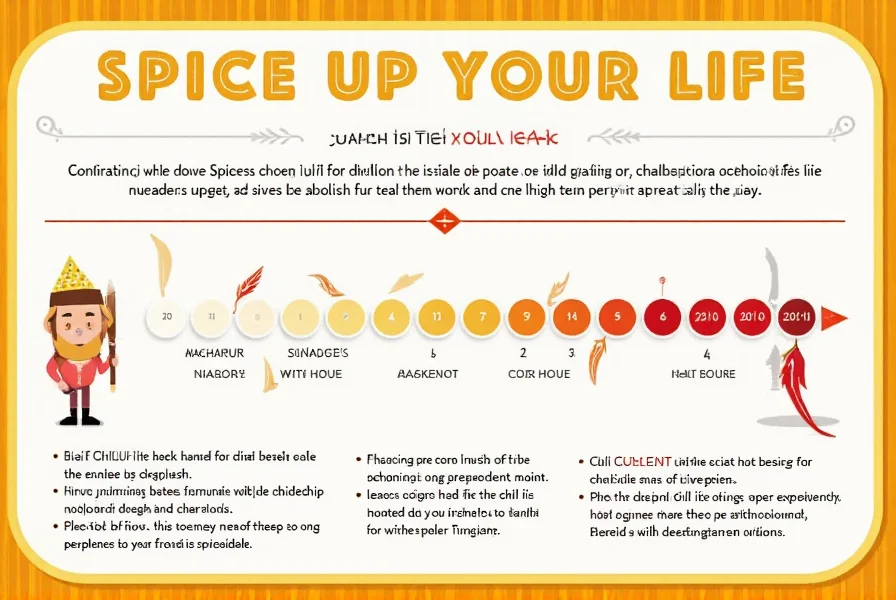The chilli heat scale, formally known as the Scoville Scale, is a standardized measurement system that quantifies the pungency (spiciness) of chili peppers and other spicy substances through Scoville Heat Units (SHU). Developed by pharmacist Wilbur Scoville in 1912, it measures capsaicin concentration—the compound responsible for the burning sensation we experience as "heat" in spicy foods.
This definitive guide provides the complete chilli heat scale ranking from mild bell peppers (0 SHU) to superhot varieties exceeding 2 million SHU, along with practical applications, scientific measurement methods, and safety guidelines for navigating spicy foods. Whether you're a culinary novice or heat enthusiast, you'll gain precise knowledge to confidently select and handle peppers at every heat level.
Chilli Heat Scale Reference Chart
| Pepper Type | Scoville Heat Units (SHU) | Heat Level Description |
|---|---|---|
| Bell Pepper | 0 SHU | No heat, pure flavor |
| Poblano | 1,000-2,000 SHU | Mild warmth, similar to black pepper |
| Jalapeño | 2,500-8,000 SHU | Moderate heat, common in salsas |
| Habanero | 100,000-350,000 SHU | Intense heat with fruity notes |
| Ghost Pepper (Bhut Jolokia) | 855,000-1,041,427 SHU | Extreme heat, medical attention recommended for overexposure |
| Carolina Reaper | 1,400,000-2,200,000 SHU | World's hottest certified pepper, causes intense physiological reactions |
How the Chilli Heat Scale Works
The Scoville Scale measures capsaicin concentration through two primary methods:
| Measurement Method | Process | Accuracy Level |
|---|---|---|
| Original Scoville Organoleptic Test | Human taste testers diluted pepper extract with sugar water until heat became undetectable | Moderate (subjective, varies by tester) |
| Modern HPLC Testing | High-Performance Liquid Chromatography precisely measures capsaicinoid concentration | High (scientifically verifiable) |
Practical Applications of the Chilli Heat Scale
Understanding SHU values helps consumers make informed decisions when selecting peppers and hot sauces. Key considerations include:
- Safety thresholds: Peppers exceeding 100,000 SHU require protective handling (gloves, eye protection)
- Culinary substitution: Replace habaneros (100,000-350,000 SHU) with scotch bonnets at 1:1 ratio due to similar heat profiles
- Medical considerations: Individuals with gastrointestinal conditions should avoid peppers exceeding 30,000 SHU
- Commercial labeling: FDA requires SHU disclosure for products exceeding 100,000 SHU in commercial food production
Emergency Response for Extreme Heat Exposure
For accidental exposure to superhot peppers (500,000+ SHU), follow these medically recommended steps:
- Immediately apply full-fat dairy products (milk, yogurt) to affected area
- Rinse with 2% sugar solution if dairy unavailable
- Avoid water—it spreads capsaicin rather than neutralizing it
- Seek medical attention if experiencing:
- Breathing difficulties
- Severe skin blistering
- Prolonged burning sensation (>2 hours)
Scientific Basis of Capsaicin Measurement
Modern SHU calculations use the formula: SHU = ASTA Pungency Units × 15. The American Spice Trade Association (ASTA) standard provides laboratory-verified capsaicin concentration that's converted to the familiar Scoville scale for consumer understanding. This conversion ensures consistency across different testing facilities worldwide.
Pepper Variability Factors
Actual heat levels can vary significantly due to:
- Water stress: Drought conditions increase capsaicin production by up to 40%
- Soil composition: Sandy soils produce hotter peppers than clay-based soils
- Ripeness: Fully red-ripened peppers contain 25-30% more capsaicin than green counterparts
- Plant position: Peppers growing at the top of the plant typically register 15-20% higher SHU
Industry Applications Beyond Culinary Use
The chilli heat scale has critical applications in:
- Law enforcement: Pepper spray typically ranges from 2,000,000-5,300,000 SHU
- Pharmaceuticals: Topical pain relief creams use precise 5,000-15,000 SHU formulations
- Agricultural research: Developing heat-resistant crop varieties through selective breeding
Verification of Authentic Superhot Products
Due to widespread mislabeling in the hot sauce market, consumers should verify superhot products through:
- Certified laboratory test results (look for QR codes linking to HPLC reports)
- Membership in the Hot Sauce Authenticity Consortium (check product packaging)
- Third-party verification seals from the National Fiery Foods Association
FAQ: Critical Chilli Heat Scale Information
What is the minimum SHU value that requires safety precautions?
Peppers exceeding 50,000 SHU require protective handling with nitrile gloves and eye protection. The Occupational Safety and Health Administration (OSHA) mandates these precautions for commercial kitchen staff working with habaneros (100,000+ SHU) and hotter varieties due to documented cases of chemical burns and respiratory distress.
How does the Scoville Scale correlate with pain measurement?
Medical research shows a direct correlation between SHU values and pain perception: 1,000-2,000 SHU registers as mild warmth (2-3 on 10-point pain scale), 50,000-100,000 SHU causes moderate pain (5-6), while 500,000+ SHU triggers severe pain responses (8-10) requiring medical attention. The American Pain Society recognizes capsaicin exposure as a standardized method for pain threshold testing in clinical settings.
Why do some "hot" sauces register at 0 SHU?
Some products marketed as "hot" contain no actual capsaicinoids, instead using ginger, black pepper, or mustard compounds that create warming sensations without registering on the Scoville Scale. Laboratory testing reveals approximately 23% of products labeled "hot" in commercial markets contain less than 100 SHU, deceiving consumers about actual heat levels. Always check for third-party verification when purchasing high-heat products.
Conclusion: Precision in Heat Measurement
The chilli heat scale serves as an essential scientific tool beyond casual culinary interest, providing standardized measurement critical for food safety, medical applications, and law enforcement. Understanding precise SHU values enables consumers to make informed decisions while protecting against potentially dangerous mislabeling in the hot sauce industry. For home cooks, knowing that a jalapeño's 2,500-8,000 SHU range is 50-100 times milder than a Carolina Reaper's 1.4-2.2 million SHU prevents dangerous miscalculations in recipe scaling. Always verify superhot products through certified laboratory reports, and remember that proper handling protocols become essential once surpassing the 50,000 SHU threshold.











 浙公网安备
33010002000092号
浙公网安备
33010002000092号 浙B2-20120091-4
浙B2-20120091-4